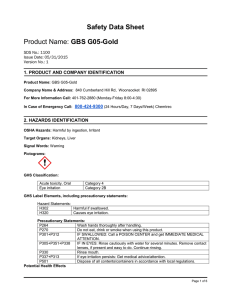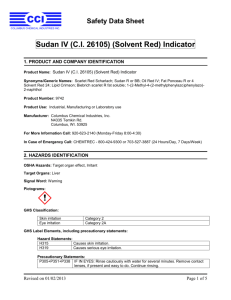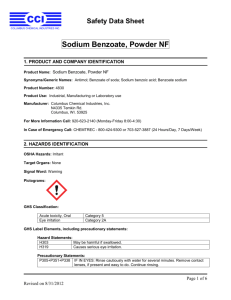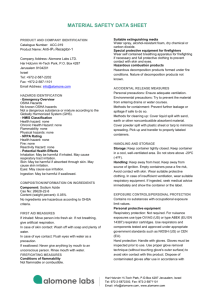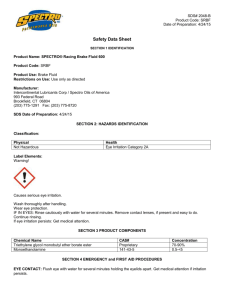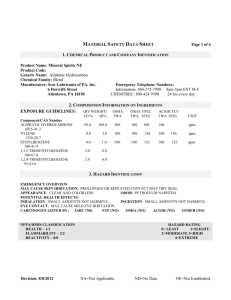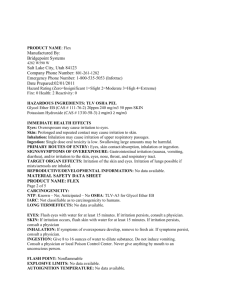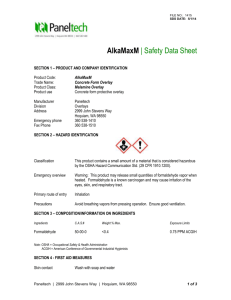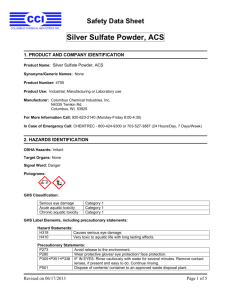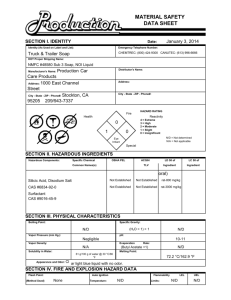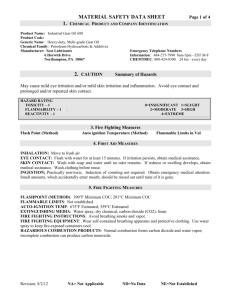GBS Type
advertisement
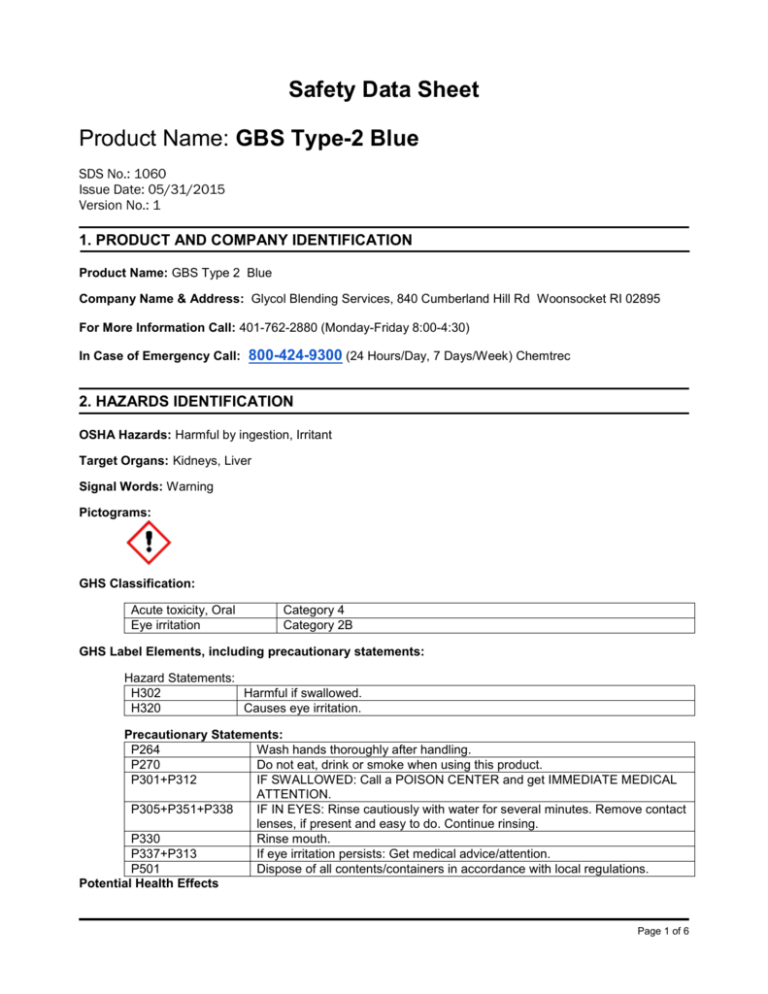
Safety Data Sheet Product Name: GBS Type-2 Blue SDS No.: 1060 Issue Date: 05/31/2015 Version No.: 1 1. PRODUCT AND COMPANY IDENTIFICATION Product Name: GBS Type 2 Blue Company Name & Address: Glycol Blending Services, 840 Cumberland Hill Rd Woonsocket RI 02895 For More Information Call: 401-762-2880 (Monday-Friday 8:00-4:30) In Case of Emergency Call: 800-424-9300 (24 Hours/Day, 7 Days/Week) Chemtrec 2. HAZARDS IDENTIFICATION OSHA Hazards: Harmful by ingestion, Irritant Target Organs: Kidneys, Liver Signal Words: Warning Pictograms: GHS Classification: Acute toxicity, Oral Eye irritation Category 4 Category 2B GHS Label Elements, including precautionary statements: Hazard Statements: H302 Harmful if swallowed. H320 Causes eye irritation. Precautionary Statements: P264 Wash hands thoroughly after handling. P270 Do not eat, drink or smoke when using this product. P301+P312 IF SWALLOWED: Call a POISON CENTER and get IMMEDIATE MEDICAL ATTENTION. P305+P351+P338 IF IN EYES: Rinse cautiously with water for several minutes. Remove contact lenses, if present and easy to do. Continue rinsing. P330 Rinse mouth. P337+P313 If eye irritation persists: Get medical advice/attention. P501 Dispose of all contents/containers in accordance with local regulations. Potential Health Effects Page 1 of 6 Eyes Inhalation Skin Ingestion May cause eye irritation. May be harmful if inhaled. May cause respiratory tract irritation. May be harmful if absorbed through skin. May cause skin irritation. May be harmful if swallowed. NFPA Ratings Health Flammability Reactivity Specific hazard HMIS Ratings 2 0 0 N/A Health Fire Reactivity Personal 2 0 0 C 0 =minimal 1= slight 2=moderate 3= serious 4= severe 3. COMPOSITION/INFORMATION ON INGREDIENTS Component Volume % CAS # EINECS# / ELINCS# Formula Molecular Weight Ethylene Glycol ≥50 107-21-1 203-473-3 C2H6O2 62.07 g/mol Antifreeze Inhibitors* <2 Proprietary Proprietary Proprietary Proprietary Dye <1 N/A N/A N/A N/A Deionized Water Balance 7732-18-5 231-791-2 H20 18.00 g/mol *Chemicals listed are only those ingredients which are not trade secrets, are classified as health hazards and are present above their concentration limits. 4. FIRST-AID MEASURES Eyes Inhalation Skin Ingestion Immediately rinse with plenty of water for at least 15 minutes and seek medical attention immediately. Move casualty to fresh air and keep at rest. If breathing is difficult, give oxygen. If not breathing, give artificial respiration. Get medical attention immediately. Immediately flush with plenty of water for at least 15 minutes while removing contaminated clothing and wash using soap. Get medical attention immediately. Do Not Induce Vomiting! Never give anything by mouth to an unconscious person. If conscious, wash out mouth with water. Get medical attention immediately. 5. FIRE-FIGHTING MEASURES Suitable (and unsuitable) extinguishing media Special protective equipment and precautions for firefighters Specific hazards arising from the chemical Product is not flammable. Use water, fog, foam, carbon dioxide or dry chemical on fires involving this product. Use appropriate media for adjacent fire. Cool unopened containers with water. Do not release runoff from fire control methods to sewers or waterways. Because fire may produce toxic thermal decomposition products, wear a self-contained breathing apparatus (SCBA) with a full face piece operated in pressure-demand or positive-pressure mode. Full protective equipment including self-contained breathing apparatus should be used during a fire. During emergency conditions, overexposure to decomposition products may cause a health hazard. Symptoms may not be immediately apparent. Seek medical attention. Closed containers may rupture or explode due to steam pressure buildup when exposed to extreme heat. Water may be used to cool closed Page 2 of 6 containers. May emit toxic fumes (oxides of carbon) under fire conditions. (See also Stability and Reactivity section). 6. ACCIDENTAL RELEASE MEASURES Personal precautions, protective equipment and emergency procedures Environmental precautions Methods and materials for containment and cleaning up See section 8 for recommendations on the use of personal protective equipment. Prevent spillage from entering drains. Any release to the environment may be subject to federal/national or local reporting requirements. Absorb spill with noncombustible absorbent material, then place in a suitable container for disposal. Clean surfaces thoroughly with water to remove residual contamination. Dispose of all waste and cleanup materials in accordance with regulations. 7. HANDLING AND STORAGE Precautions for safe handling See section 8 for recommendations on the use of personal protective equipment. Use with adequate ventilation. Wash thoroughly after using. Keep container closed when not in use. Avoid formation of aerosols. Conditions for safe storage, including any incompatibilities Store in cool, dry well ventilated area. Store only in containers that are resistant to alkaline solutions. Keep away from incompatible materials (see section 10 for incompatibilities). 8. EXPOSURE CONTROLS / PERSONAL PROTECTION Occupational exposure controls: Component Exposure Limits Basis Entity Ethylene Glycol 100 mg/m3 50 ppm 125 mg/m3 STEL STEL ACGIH OSHA TWA: Time Weighted Average over 8 hours of work. TLV: Threshold Limit Value over 8 hours of work. REL: Recommended Exposure Limit PEL: Permissible Exposure Limit STEL: Short Term Exposure Limit during x minutes. IDLH: Immediately Dangerous to Life or Health WEEL: Workplace Environmental Exposure Levels CEIL: Ceiling Personal Protection Eyes Wear chemical safety glasses or goggles, and face shield. Inhalation Provide local exhaust, preferably mechanical. If exposure levels are excessive, use an approved respirator. Skin Wear nitrile or rubber gloves, and full body covering. The type of protective equipment must be selected according to the concentration and amount of the dangerous substance at the specific workplace. Other Not Available Other Recommendations Page 3 of 6 Provide eyewash stations, quick-drench showers and washing facilities accessible to areas of use and handling. 9. PHYSICAL AND CHEMICAL PROPERTIES Appearance (physical state, color, etc.) Odor pH Specific gravity Freezing point Boiling point Flash point Flammability (solid, gas) Upper/lower flammability or explosive limit Vapor pressure Vapor density Solubility Percent volatile by Volume Liquid, Dark Blue Slight Glycol Odor 8.5-9.5 1.045 min. -36°C (-34°F) 109°C (229°F) Not Flammable Not Flammable Not Explosive 10 mmHg at 20°C (68°F) 2.1 (air = 1) Completely soluble in water. NIL 10. STABILITY AND REACTIVITY Chemical Stability Possibility of Hazardous Reactions Conditions to Avoid Incompatible Materials Hazardous Decomposition Products Stable Will not occur. Storage below 15.5°C (60°F) or above 65.5°C (150°F) Strong acids, oxidizers. Oxides of carbon. 11. TOXICOLOGICAL INFORMATION Acute Toxicity Ethylene Glycol Skin Eyes Respiratory Ingestion LD50 Dermal - rabbit - 10,626 mg/kg Eyes - rabbit - Mild eye irritation - 24 h Not Available LD50 Oral - rat - 4,700 mg/kg Carcinogenicity IARC No components of this product present at levels greater than or equal to 0.1% is identified as probable, possible or confirmed human carcinogen by IARC. ACGIH No components of this product present at levels greater than or equal to 0.1% is identified as a carcinogen or potential carcinogen by ACGIH. NTP No components of this product present at levels greater than or equal to 0.1% is identified as a known or anticipated carcinogen by NTP. OSHA No components of this product present at levels greater than or equal to 0.1% is identified as a carcinogen or potential carcinogen by OSHA. Signs & Symptoms of Exposure Skin Brief contact is not irritating. Prolonged contact, as well as clothing wetted with material may cause defatting of skin or irritation, seen as local redness with possibility of mild discomfort. Eyes Eye burns, watering eyes, redness. Respiratory Irritation of nose and/or throat, drowsiness, headache, nausea. Page 4 of 6 Ingestion Toxic when swallowed. Lethal dose for adults is 1-2mL per kilogram. Symptoms of exposure may include headache, weakness, confusion, nausea, dizziness, staggering gait, slurred speech, loss of concentration, faintness, vomiting, increased heart rate, decreased blood pressure, difficulty breathing, and pulmonary edema. Severe poisoning may cause death. Chronic Toxicity Teratogenicity Mutagenicity Embryotoxicity Specific Target Organ Toxicity Reproductive Toxicity Respiratory/Skin Sensitization Repeated overexposure may aggravate existing kidney disease. Repeated ingestion may cause kidney damage. Not Available Not Available Not Available Not Available Not Available Not Available 12. ECOLOGICAL INFORMATION Ecotoxicity Ethylene Glycol Aquatic Vertebrate Aquatic Invertebrate Terrestrial LC50 - Oncorhynchus mykiss (rainbow trout) - 18,500 mg/l - 96 h LC50 - Leuciscus idus (Golden orfe) - > 10,000 mg/l - 48 h NOEC - Pimephales promelas (fathead minnow) - 32,000 mg/l - 7 d NOEC - Pimephales promelas (fathead minnow) - 39,140 mg/l - 96 h EC50 - Daphnia magna (Water flea) - 74,000 mg/l - 24 h NOEC - Daphnia - 24,000 mg/l - 48 h LC50 - Daphnia magna (Water flea) - 41,000 mg/l - 48 h Not Available Persistence and Degradability Bioaccumulative Potential Mobility in Soil PBT and vPvB Assessment Other Adverse Effects Biodegradable. Not Available Not Available Not Available Not Available 13. DISPOSAL CONSIDERATIONS Waste Residues Product Containers Users should review their operations in terms of the applicable federal/national or local regulations and consult with appropriate regulatory agencies if necessary before disposing of waste product or residues. Users should review their operations in terms of the applicable federal/national or local regulations and consult with appropriate regulatory agencies if necessary before disposing of waste product container. The information offered in section 13 is for the product as shipped. Use and/or alterations to the product may significantly change the characteristics of the material and alter the waste classification and proper disposal methods. 14. TRANSPORTATION INFORMATION US DOT TDG IMDG Marine Pollutant Not Dangerous Goods Not Dangerous Goods Not Dangerous Goods No Page 5 of 6 IATA/ICAO Not Dangerous Goods 15. REGULATORY INFORMATION TSCA Inventory Status DSCL (EEC) California Proposition 65 SARA 302 SARA 304 SARA 311 SARA 312 SARA 313 WHMIS Canada All ingredients are listed on the TSCA inventory. All ingredients are listed on the DSCL inventory. Not Listed Not Listed Not Listed Acute Health Hazard Acute Health Hazard Not Listed Class D-2A: Poisonous and infectious material- Other effects- Very toxic Class D-1B: Poisonous and infectious material- Immediate and serious effects- Toxic 16. OTHER INFORMATION Revision Date Disclaimer: We believe that the information herein is factual but is not intended to be all inclusive. The information relates only to the specific material designated and does not relate to its use in combination with other materials or its use as to any particular process. Because safety standards and regulations are subject to change and because we have no continuing control over the material, those handling, storing or using the material should satisfy themselves that they have current information regarding the particular way the material is handled, stored or used and that the same is done in accordance with federal, state and local law. WE MAKE NO WARRANTY, EXPRESS OR IMPLIED, INCLUDING (WITHOUT LIMITATION) WARRANTIES WITH RESPECT TO THE COMPLETENESS OR CONTINUING ACCURACY OF THE INFORMATION CONTAINED HEREIN OR WITH RESPECT TO FITNESS FOR ANY PARTICULAR USE. Page 6 of 6
